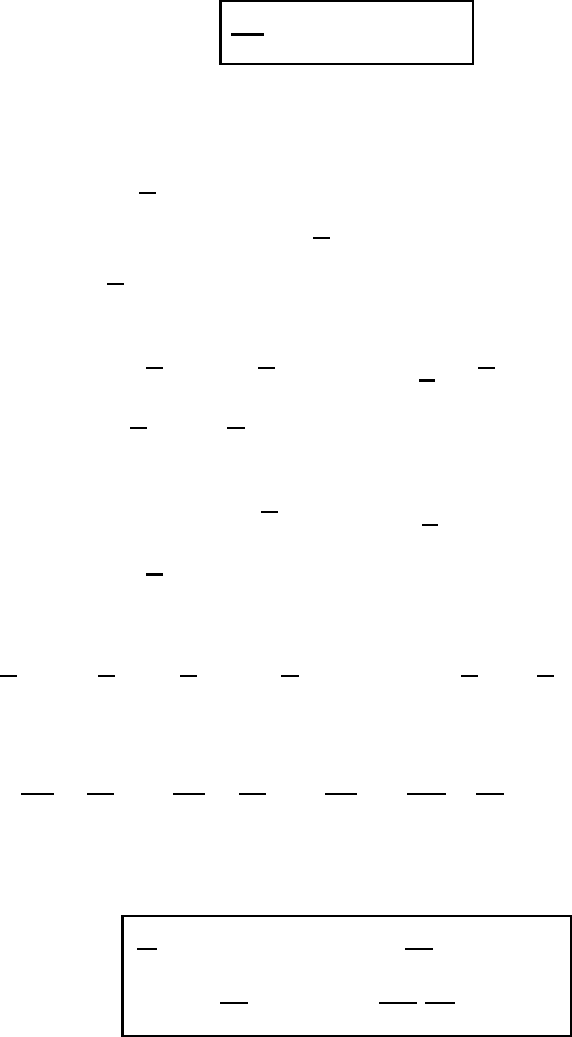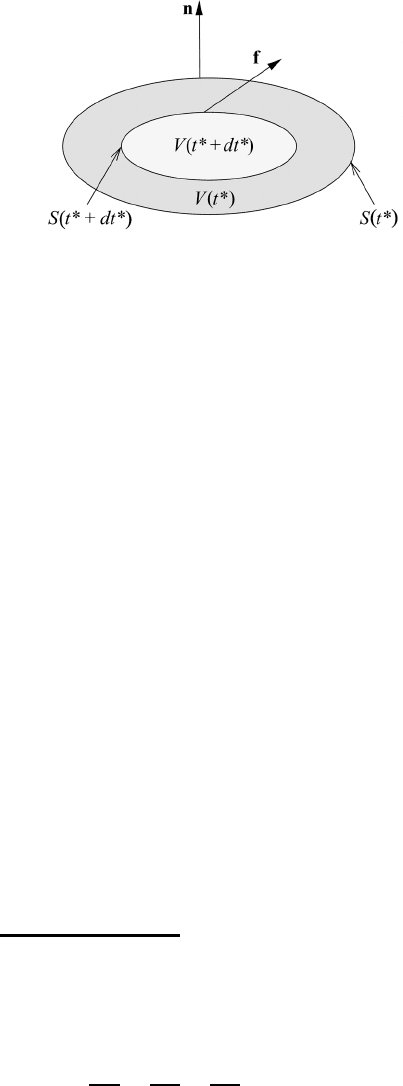Zdunkowski W., Bott A. Dynamics of the atmosphere: A course in theoretical meteorology
Подождите немного. Документ загружается.


27.1 Derivation and discussion of the Lorenz equations 671
On replacing T
0
in this expression by T
m
and α
0
by α
m
we obtain the equation of
state for the specific volume:
α(T ) = α
m
(1 + T
1
)(27.8)
where α
m
is the mean value of the specific volume of the entire region of convection
and = 1/T
m
is the cubic expansion coefficient of the air.
Next we need a suitable expression for the pressure p(x,z, t), which may be
expressed as the sum of the hydrostatic pressure p
h
(x,z, t) and the deviation
p
(x,z, t) from this value. Let p
h
(z, t) represent the horizontal average of the
hydrostatic pressure at height z and time t and
p
h
(z, 0) be the initial value at time
t = t
0
. Furthermore, we introduce a new pressure variable P according to
P (x,z, t) = [p(x,z,t) −
p
h
(z, 0)]α
m
= [p(x,z, t) − p
h
(z
t
, 0)]α
m
− g(z
t
− z)
with p(x, z,t) = p
h
(x,z, t) + p
(x,z, t),
p
h
(z, 0) = p
h
(z
t
, 0) +
g
α
m
(z
t
− z)
(27.9)
where z
t
denotes the top of the convective layer. In reality P has dimensions of
energy per unit mass. Thus we may express the Jacobian J (α, −p)by
J (α, −p) = J
α
m
(1 + T
1
), −
P
α
m
− p
h
(z
t
, 0) −
g
α
m
(z
t
− z)
(27.10a)
Expansion of the Jacobian yields
J (α, −p) = J(T
1
, −P ) + g
∂T
1
∂x
≈ g
∂T
1
∂x
(27.10b)
The first term on the right-hand side of this expression is of second order in
comparison with the second term and has, therefore, been neglected. By utilizing
(27.10b) in (27.5) we obtain Saltzman’s approximate form of the vorticity equation:
∂
∂t
∇
2
v
ψ
+ J
ψ, ∇
2
v
ψ
= g
∂T
1
∂x
+ ν ∇
2
v
∇
2
v
ψ
(27.11)
This is an equation in two unknowns involving the stream function ψ and the
temperature deviation T
1
. Therefore, a second prognostic equation is needed in
order to determine T
1
. In order to avoid the appearance of new dependent variables
Saltzman chooses the very simplified form of the heat equation
∂T
1
∂t
+ v
v
·∇
v
T
1
= K ∇
2
v
T
1
(27.12)

672 Predictability
where K is the exchange coefficient for heat. Introducing the stream function ψ
according to (27.4), the heat equation can be written in the concise form
∂T
1
∂t
+ J (ψ, T
1
) = K ∇
2
v
T
1
(27.13)
Thus equations (27.11) and (27.13) describe the model convection in the (x,z)-
plane. It should be realized that, due to the appearance of clouds and phase transi-
tions, the actual convective processes are much more complicated.
The temperature deviation T
1
may be decomposed and expressed as the sum of
an average value
T
1
(z, t) along the x-axis plus the deviation T
1
(x,z, t):
T
1
(x,z, t) = T
1
(z, t) + T
1
(x,z, t)(27.14)
Furthermore, T
1
(z, t) can be decomposed into a part representing a linear variation
between the upper and lower boundary and a departure T
from the linear variation:
T
1
(z, t) =
T
1
(0,t) − T
0
(t)
z
z
t
+ T
1
(z, t)(27.15)
with T
0
(t) = T
1
(0,t) − T
1
(z
t
,t). Now equation (27.14) can be written in the
following form:
T
1
(x,z, t) =
T
1
(0,t) − T
0
(t)
z
z
t
+ ϑ(x,z,t)(27.16)
with ϑ(x,z,t) =
T
1
(z, t) + T
1
(x,z, t). Saltzmann assumes that the temperatures
at the lower and upper model boundaries are kept constant by external heating.
This implies
T
1
(0,t) = T
1
(0), T
1
(z
t
,t) = T
1
(z
t
) =⇒ T
0
= T
1
(0) − T
1
(z
t
) = constant
(27.17)
so that
∂T
1
∂t
=
∂ϑ
∂t
,
∂T
1
∂x
=
∂ϑ
∂x
,
∂T
1
∂z
=−
T
0
z
t
+
∂ϑ
∂z
, ∇
2
v
T
1
=∇
2
v
ϑ
(27.18)
follow from (27.16) and (27.17). From (27.11) and (27.13) we finally find a pair of
partial differential equations describing the convection
∂
∂t
∇
2
v
ψ
+ J
ψ, ∇
2
v
ψ
= g
∂ϑ
∂x
+ ν ∇
2
v
(∇
2
v
ψ)
∂ϑ
∂t
+ J (ψ, ϑ) =
T
0
z
t
∂ψ
∂x
+ K ∇
2
v
ϑ
(27.19)

27.1 Derivation and discussion of the Lorenz equations 673
The first terms on the right-hand sides of (27.19) represent the driving forces of
the convection while the second terms cause damping due to viscosity and heat
conduction.
We wish to introduce the dimensionless Rayleigh number, which is defined by
Ra =
gz
3
t
T
0
νK
(27.20)
Ra is a measure of convective instability. The numerator of Ra involves the buoy-
ancy force per unit mass gT
0
while the denominator denotes damping expressed
by the kinematic viscosity ν and the heat-conduction coefficient K.Ifz
t
and l
stand for the height and the width of the convection rolls, the aspect ratio a = z
t
/l
defines the critical Rayleigh number
Ra
c
=
π
4
(1 + a
2
)
3
a
2
(27.21)
The critical Rayleigh number depends on the geometric parameters of the model.
Whenever the ratio r = Ra/Ra
c
> 1, convection is expected to occur.
Saltzman (1962) assumes that the stream function and the temperature departure
in equation (27.19) can be expressed as sums of double Fourier components.
Lorenz (1963), motivated by Saltzman’s work, assumed the validity of the simple
trial solutions
ψ =
√
2(1 + a
2
)K
a
X(t)sin
πax
z
t
sin
πz
z
t
ϑ =
T
0
πr
Y (t)
√
2cos
πax
z
t
sin
πz
z
t
− Z(t)sin
2πz
z
t
(27.23)
containing only three development coefficients X(t),Y(t),Z(t), which are slowly
varying amplitudes in time. According to the trial solution, the X mode represents
the flow pattern, the Y mode the temperature cells, and the Z mode the temperature
stratification. When equations (27.23) are substituted into (27.19), ignoring trigono-
metric terms that do not occur in the trial solution, we obtain the famous Lorenz
system consisting of three ordinary differential equations in dimensionless time t
∗
:
dX
dt
∗
=
˙
X =−σX + σY = f
1
(X,Y,Z)
dY
dt
∗
=
˙
Y = rX − Y − XZ = f
2
(X,Y,Z)
dZ
dt
∗
=
˙
Z = XY − bZ = f
3
(X,Y,Z)
with t
∗
=
π
2
(a
2
+ 1)K
z
2
t
t, σ =
ν
K
,b=
4
a
2
+ 1
> 0,r=
Ra
Ra
c
(27.24)
674 Predictability
The term σ is the Prandtl number. The consequence of the simplification is that
the advection term in the first equation of (27.19) is suppressed.
The Lorenz system is a three-dimensional autonomous dynamic system, which
may formally be expressed by
˙
X = f(X)withX = (X,Y,Z)(27.25)
If the function f depends not only on the vector X but also explicitly on time t,we
speak of a nonautonomous dynamic system. This type of system is more difficult
to handle.
Owing to the simplifications introduced by Lorenz, this approach does not re-
alistically model convection rolls. What Lorenz had in mind was to show that the
low-order nonlinear dynamic system (27.24) with only three degrees of freedom
reacts very sensitively to small variations in the initial conditions. This simple fact
has many important consequences for weather prediction.
The discussion of simple properties of the Lorenz system requires that the reader
is somewhat familiar with a few basic concepts of nonlinear dynamics. Some
readers may be quite familiar with this subject; others may wish to consult one of
the many textbooks which are available at all levels of sophistication. For the reader
entirely unfamiliar with the subject, we gave a brief and incomplete introduction
in Chapter M7. There we extract most of the required information from Strogatz’s
excellent book on Nonlinear Dynamics and Chaos (1994). His very informative
book is much more than a first introduction. It provides pleasant reading at a level
of mathematical sophistication that does not exceed the usual background of a
senior student in meteorology. The next four sections again follow his book.
Inspection of (27.24) shows that the only nonlinearities are the quadratic terms
XY and XZ. Lorenz found that, over a wide range of parameters, the numerical
solutions oscillate irregularly in time, but they never exactly repeat. This led him to
title his now famous paper “Deterministic Non-Periodic Flow”. Moreover, he found
that the solutions to (27.24) always remain in a bounded region of phase space.
When he plotted the trajectories in three dimensions, there emerged a strange figure
that resembled a pair of butterfly wings. This figure is now called a strange attractor.
In the following we list important simple properties of the Lorenz equations.
27.1.1 Nonlinearity
The Lorenz system consists of the two nonlinearities XY and XZ.

27.1 Derivation and discussion of the Lorenz equations 675
Fig. 27.1 Contraction in volume of a dissipative system.
27.1.2 Symmetry
On replacing (X,Y) in (27.24) by (−X, −Y ), the equations do not change. Thus,
if [X(t
∗
),Y(t
∗
),Z(t
∗
)] is a solution to (27.24), so is [−X(t
∗
), −Y (t
∗
),Z(t
∗
)].
27.1.3 The Lorenz system is dissipative
In general, a dynamic system is either conservative or dissipative. An important
property of phase space is the preservation of phase volume of conservative or
constant-energy systems. For dissipative systems, the volume in phase space con-
tracts under the flow. In this case the divergence of the phase velocity is negative.
In contrast, if the divergence is zero, the dynamic system is conservative.
To illuminate the idea, we consider an arbitrary closed surface S(t
∗
)ofthe
volume V (t
∗
) as shown in Figure 27.1. We may think of points on S as initial
conditions for trajectories that evolve during the time interval dt
∗
, thus resulting
in a change in volume. What is the volume at time t
∗
+ dt
∗
? As usual, the vector
n denotes the outward normal on S. We do not have to restrict ourselves to the
Lorenz system, but we consider the arbitrary three-dimensional system
˙
X = f(X).
The scalar product f · n is the outward normal component of the velocity vector
˙
X. During the time interval dt
∗
a patch of surface area dS = n dS sweeps out a
volume element dV = (f · n dt
∗
) dS = V (t
∗
+ dt
∗
) − V (t
∗
). Integrating over all
patches yields
˙
V =
V (t
∗
+ dt
∗
) − V (t
∗
)
dt
∗
=
S
f · n dS =
V
∇·f dV (27.26)
where we have used Gauss’ divergence theorem (M6.31). For the Lorenz system
the divergence ∇·f turns out to be
∇·f =
∂f
1
∂X
+
∂f
2
∂Y
+
∂f
3
∂Z
=−(σ + 1 + b) < 0(27.27)

676 Predictability
On substituting this expression into (27.26) we obtain for the change of the
volume with time
˙
V (t
∗
) =−(σ + 1 + b)V (t
∗
)(27.28a)
from which it follows that
V (t
∗
) = V (0) exp[−(σ + 1 + b)t
∗
](27.28b)
Thus the volume in phase space shrinks exponentially fast. This implies that a
large blob of initial conditions eventually shrinks to a limiting set of zero volume.
Stating it differently, all trajectories starting in the blob end up somewhere in the
limiting set. We recognize that volume contraction imposes stringent constraints
on possible candidate solutions.
27.1.4 Fixed points
The Lorenz system has two types of fixed points.
(1) The origin is a fixed point for all parameter values of r, σ, b:
(X
∗
,Y
∗
,Z
∗
) = (0, 0, 0) (27.29a)
This state at the origin of the phase space does not describe any convection, but
rather describes the equalization of temperature resulting from conduction of heat.
The system remains at rest.
(2) For r>1 there is a pair of symmetric fixed points. Setting
˙
X = 0,
˙
Y = 0,
˙
Z = 0 in (27.24) gives
X
∗
=±
b(r − 1),Y
∗
= X
∗
,Z
∗
= r − 1(27.29b)
Lorenz called these symmetric points C
+
and C
−
.Asr → 1, the symmetric fixed
points collide with the origin in a pitchfork bifurcation. Of meteorological interest
is that the symmetric fixed points represent left- or right-turning convection rolls.
27.1.5 Linear stability at the origin
The three-dimensional Jacobian matrix of the system is given by
A =
∂f
1
∂X
∂f
1
∂Y
∂f
1
∂Z
∂f
2
∂X
∂f
2
∂Y
∂f
2
∂Z
∂f
3
∂X
∂f
3
∂Y
∂f
3
∂Z
=
−σσ 0
r − Z −1 −X
YX−b
(27.30)

27.1 Derivation and discussion of the Lorenz equations 677
By evaluating this matrix at the origin we obtain for the linearized system
˙
X
˙
Y
˙
Z
=
−σσ 0
r −1 −0
00−b
X
Y
Z
(27.31)
From this equation we recognize that the Z-component is uncoupled from the
remaining system, so
˙
X
˙
Y
=
−σσ
r −1
X
Y
,
˙
Z =−bZ (27.32)
Hence Z(t
∗
) is proportional to exp(−bt
∗
), i.e. Z(t
∗
) is decreasing exponentially
fast to zero as t
∗
→∞. The trace and the determinant of the square matrix in
(27.32) are given by
τ = λ
1
+ λ
2
=−(σ + 1),= λ
1
λ
2
= σ (1 − r)(27.33)
According to Figure M7.13, for r>1 the origin is a saddle point since the
determinant <0. It is easy to show that, in this case, one of the eigenvalues of
the two-dimensional system is negative, while the other one is positive. Counting
the Z-component, we have two incoming and one outgoing directions. If r<1all
eigenvalues are negative. This means that all directions are incoming, so the origin
is a sink. In this case τ
2
− 4 = (σ − 1)
2
+ 4σr > 0. Thus Figure M7.13 reveals
that, for r<1, the origin is a stable node.
We will now verify that, for r<1, every trajectory approaches the origin as the
time t
∗
approaches infinity. This implies that the origin is a globally stable point.
Hence there can be no limit cycle or chaos for r<1. We verify this statement with
the help of the Liapunov function
V (X,Y,Z) =
1
σ
X
2
+ Y
2
+ Z
2
(27.34)
Surfaces V = constant are concentric ellipsoids about the origin. First we wish to
show that, for (X,Y,Z) = (0, 0, 0) and r<1, the time derivative of the volume is
negative. Carrying out the differentiation dV/dt
∗
using (27.24), we find
1
2
˙
V =
1
σ
X
˙
X + Y
˙
Y + Z
˙
Z
= (XY − X
2
) + (rXY − Y
2
− XYZ) + (XYZ − bZ
2
)
= (r + 1)XY − X
2
− Y
2
− bZ
2
(27.35)

678 Predictability
Completing squares results in
1
2
˙
V =−
X −
r + 1
2
Y
2
−
1 −
r + 1
2
2
Y
2
− bZ
2
(27.36)
Inspection shows that, for r<1, this expression cannot be positive. The question
of whether
˙
V could be zero arises. This is possible only if each term on the right-
hand side vanishes separately. This happens if (X,Y,Z) = (0, 0, 0). The total
conclusion is that
˙
V = 0 only if (X,Y,Z) = (0, 0, 0); otherwise
˙
V<0andthe
origin is globally stable.
27.1.6 Stability of C
+
and C
−
By evaluating the left-hand side of (27.30) at (X
∗
,Y
∗
,Z
∗
) = (C
±
,C
±
,r − 1) we
obtain
−σσ 0
r − Z −1 −X
YX−b
C
±
,C
±
,r−1
=
−σσ 0
1 −1 ∓
b(r − 1)
±
b(r − 1) ±
b(r − 1) −b
(27.37)
The three eigenvalues of this linear system are found by solving the equation for
the determinant
|
A − λE
|
= 0, resulting in the characteristic equation
λ
3
+ (σ + b + 1)λ
2
+ b(σ + r)λ + 2bσ(r − 1) = 0(27.38)
Inspection of the fixed points C
±
=±
√
b(r − 1) shows that the condition r ≥ 1
must hold, otherwise C
+
and C
−
cannot exist.
First let us consider the special case that r = 1, that is Ra = Ra
c
, marking the
onset of convection. It is not difficult to recognize from (27.38) that the eigenvalues
are given by λ
1
= 0,λ
2
=−b, λ
3
=−(σ + 1). In this case one speaks of the
margin of stability since no eigenvalue is larger than zero.
In order to study the characteristic equation in the more general case, we write
equation (27.38) in the form
λ
3
+ a
2
λ
2
+ a
1
λ + a
0
= 0(27.39)

27.1 Derivation and discussion of the Lorenz equations 679
According to Vieta’s theorem, see for example Abramowitz and Segun (1968),
there exists the relation
λ
1
λ
2
λ
3
=−a
0
(27.40)
By substituting λ
2
=−b and λ
3
=−(σ + 1) into this equation, we obtain an
approximate value for λ
1
,whichmaybeusedifr ≈ 1:
λ
1
≈−
2σ (r − 1)
1 + σ
for r ≈ 1(27.41)
Thus, for r>1 and in the limit r → 1, stability is lost because the approximate
negative eigenvalue λ
1
approaches 0.
Now suppose that r>1 so that all coefficients in the characteristic equation
(27.38) are positive. The theory of cubic equations provides several intricate re-
lationships for the roots of this equation involving the coefficients a
0
,a
1
,anda
2
.
With some patience one can show that there exists one real root and two complex-
conjugate roots. We have shown already by an approximate method that the real
root λ
1
< 0sothatλ
2,3
= λ
r
±iλ
i
. Convection rolls remain stable as long as λ
r
< 0
and begin to be unstable if λ
r
= 0sothatλ
2,3
are purely imaginary. In this case r
assumes a critical value r
H
where the subscript H has been used to show that C
+
and C
−
lose stability at the Hopf bifurcation at r = r
H
.
We will now find an expression for r = r
H
. According to a theorem attributed to
Vieta, the sum of the roots is given by
λ
1
+ λ
2
+ λ
3
=−a
2
=−(σ + b + 1) (27.42)
Since the complex conjugates are purely imaginary, the sum of the complex con-
jugates λ
2
+ λ
3
is zero, so we obtain
λ
1
=−(σ + b + 1) (27.43)
Substituting (27.43) into (27.38) results in
−(σ + b + 1)
3
+ (σ + b + 1)(σ + b + 1)
2
− b(σ + r)(σ + b + 1) + 2bσ(r − 1) = 0
(27.44)
After some elementary algebra we find the desired expression for r
H
:
r = r
H
=
σ (σ + b + 3)
σ − b − 1
(27.45)
To repeat, the quantity r
H
is that value of r for which the complex-conjugate roots
are purely imaginary. Instability can arise only for such σ, b that r
H
> 1. Thus
the fixed points C
+
and C
−
remain stable if and only if either of the following
condition holds:

680 Predictability
(i)
σ<b+ 1 and r>1, (ii) σ>b+ 1 and 1 <r<r
H
.
Both conditions can be readily understood. The parameter r must be larger than
1 so that the fixed points C
+
and C
−
can exist. (i) For σ<b+1 there is no positive
value of r to satify (27.45). (ii) σ>b+ 1 causes equation (27.45) to be positive
but the value of r is still less than the critical value r
H
.
In meteorological terms, stationary convection rolls remain stable as long as
either condition is satified. For large enough Rayleigh numbers the convection
becomes unstable. If the critical value r
H
is exceeded then the real parts λ
r
of the
eigenvalues λ
2,3
will be positive and irregular convective motion takes place, and
the so-called deterministic chaos may occur.
Following Lorenz, we study the particular case σ = 10. Selecting a
2
=
1
2
,we
find from (27.24) b =
8
3
,sor
H
= 24.74. Hence, on choosing r = 28, which is just
past the Hopf bifurcation, we expect something strange to happen. Steady-state con-
vection may be calculated from (27.29) to give (X
∗
,Y
∗
,Z
∗
) = (6
√
2, 6
√
2, 27) and
(−6
√
2, −6
√
2, 27) while the state of no convection corresponds to (X
∗
,Y
∗
,Z
∗
) =
(0, 0, 0).
As we know, the complete set (27.24) cannot be integrated by analytic methods.
Nonstationary solutions can be found only numerically. Lorenz began integrating
from the initial condition (0, 1, 0) which is close to the saddle point at the origin. The
result is depicted in Figure 27.2. The trajectory starts near the origin and immedi-
ately swings to the right and then dives into the center of the spiral on the left. From
there the trajectory spirals outward very slowly and then, all of a sudden, shoots
back over to the right-hand side. There it spirals around, and so on indefinitely. The
number of circuits made on either side varies unpredictably from one cycle to the
next one. The spiral leaves of the attractor simulate rising and descending air of
the convective motion.
Figure 27.2 shows what is now called a strange or chaotic attractor. The strange
attractor consists of an infinite number of closely spaced sheets having zero volume
but an infinite surface area. Numerical experiments have shown that the fractional
dimension of the Lorenz attractor is about 2.06 if the Hausdorff definition is applied.
The fractional dimension of the strange attractor implies a fractional structure of
many length scales. If one magnifies a small part of the strange attractor, new
substructures will emerge.
Figure 27.3 shows as an example the evolution of Y versus t
∗
. After reaching an
early peak, irregular oscillations persist as time increases. Since the motion never
repeats exactly, we speak of aperiodic motion.
Let us now consider the importance of Lorenz’s discoveries for weather predic-
tion. The character of chaotic dynamics can be recognized very easily by imagining
that the system is started twice but from slightly different initial conditions. We
